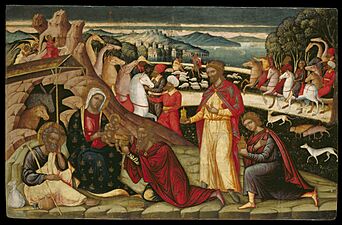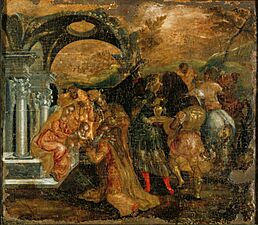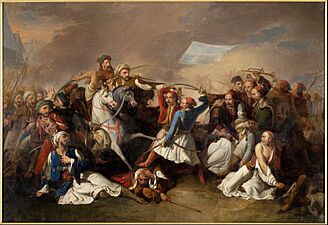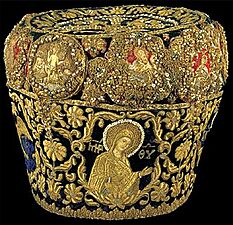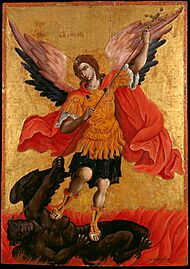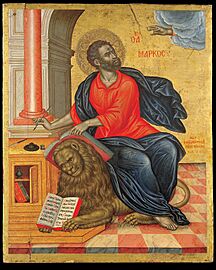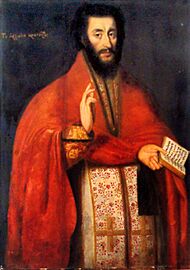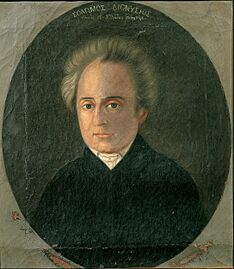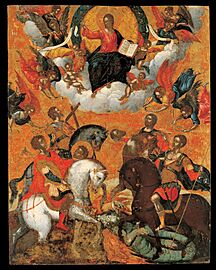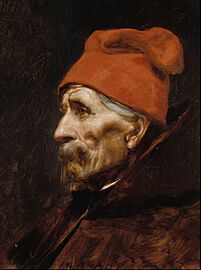Benaki Museum facts for kids
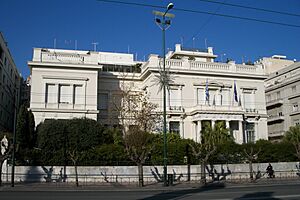 |
|
| Established | 1930 |
|---|---|
| Location | Athens, Greece |
The Benaki Museum is a super cool place in Athens, Greece. It was started in 1930 by a man named Antonis Benakis. He wanted to honor his father, Emmanuel Benakis. The museum is in the old Benakis family home.
Inside, you'll find amazing Greek art from ancient times all the way to today. It also has a big collection of art from Asia. The museum often has special shows and even has a workshop to fix old art!
When it first opened, the museum had many different types of art, like Islamic art and Chinese pottery. But after a big renovation in 2000, the main museum decided to focus mostly on Greek culture. This allowed other special museums to open for different collections. Today, the Benaki Museum in Athens holds over 100,000 items. These items show the many different times, people, and cultures that have shaped Greece. It's one of Greece's most important cultural places!
Contents
The Main Museum in Athens

The main Benaki Museum is located in the Benakis family's old house. It's right across from the National Garden on Queen Sofias Avenue. This museum exists thanks to the kindness of Antonis Benakis. His family used to live in Alexandria, Egypt.
In 1931, the Benakis family gave their Athens home and a huge collection of over 37,000 Islamic and Byzantine objects to start the museum. By the 1970s, more than 9,000 new items were added! Many other people also donated their treasures. Antonis Benakis stayed involved with the museum until he passed away in 1954.
Later, under the leadership of Angelos Delivorrias, the museum gained over 60,000 more objects, books, and documents. Some were bought, and many others were donated. Mr. Delivorrias liked to show donated items. This helped encourage people to get involved and feel connected to the museum. The museum also teaches that Greek history is a long, continuous story that is still happening today.
Some of the museum's collections have traveled all over the world! For example, they went to Canada in 2008. They also visited the United States in 1959 with the Smithsonian Institution. In 2005, a special solid gold drinking cup from Ancient Greek times left Greece for the first time. It traveled to museums in Sydney and Melbourne, Australia.
A Big Change in 2000
In 2000, the Benaki Museum reopened after a huge renovation. This project cost $20 million! The building had been damaged in an earthquake. The renovation made it the only museum in Greece that takes visitors through all the different periods of Greek culture and history. It's also special because it doesn't just focus on Greece alone. Instead, it celebrates all the different cultures that have influenced Greece.
The museum's director, Angelos Delivorrias, first thought of changing the museum's focus in 1973. But it took more than 25 years to make this idea a reality! This meant moving the museum's collections of Islamic Art and Chinese pottery to other locations. That way, the main museum in Athens could focus only on Greece.
Other Benaki Museums
Over the years, many other people have given gifts to the museum. Now, the Benaki Museum has several different locations, each with its own special collection:
- The seaside Kouloura Mansion in Palaio Phaliro, which holds the Toy Museum.
- The Benaki Museum of Islamic Art in the Kerameikos area.
- The Nikos Hadjikyriakos-Ghikas Gallery in downtown Athens.
- The Benaki Museum Pireos street Annex.
- The Penelope Delta House in Kifissia, which keeps historical documents.
Benaki Museum of Islamic Art
As part of the plan to focus the main museum on Greek culture, the Islamic art collection moved to a new home in 2004. This was just in time for the Athens Olympics! The new museum also has special rooms for temporary exhibits that travel there.
The Islamic art collections are in beautiful old buildings in the historic center of Athens. This area, called Kerameikos, is full of ancient sites. Nearby, you can find parts of the ancient Agora and the Temple of Hephaestus. There's also a museum for the ancient Kerameikos cemetery. The buildings for the Islamic Art Museum were given to the Benaki Museum by Lambros Eftaxias.
This museum opened on July 27, 2004. It has over 1,000 square meters of space to show off its treasures. You can see ceramics, metalwork, gold items, wood carvings, glasswork, and textiles. There are also bone carvings, old tombstones, and weapons. This collection is considered one of the most important in the world! It includes amazing pieces from India, Persia, Mesopotamia, the Middle East, Arabia, Egypt, North Africa, Sicily, Spain, and Asia Minor. The art covers Islamic history from the 600s to the 1800s. It has a rich collection of Ottoman art from when the Ottoman Empire was at its strongest in the 1500s.
Gallery
-
Pieta by El Greco, 1566
-
St.Mark the Evangelist by Emmanuel Tzanes, 1657
-
Dionysios Solomos, unknown artist
See also
- List of museums with major collections of Islamic art
- Cretan School
- Heptanese School


